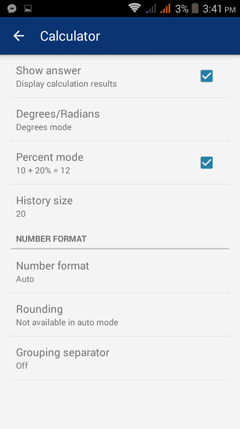2.2. Calculator Settings
CALCULATOR
Show answer
Check to show the calculation results. Uncheck to hide the results and only display the entered expressions.
Percent Mode
Enables percent mode for addition and subtraction.
See Expressions > Percents.
History Size
Enables you to change the history size from a minimum of 5 to a maximum of 100 entries.
Degrees/Radians
Switch between degrees and radians. This setting does not affect graphs and tables.
Degrees mode - numeric arguments of trigonometric functions are considered in degrees: sin 30 = 0.5
Radians mode (default) - numeric arguments of trigonometric functions are considered in radians. Use the degree sign ° to enter arguments in degrees: sin 30° = 0.5
See Expressions > Degrees.
Number format
Switch between number formats for results:
Auto - automatic format - integer/fraction/decimal.
Scientific - convert results to scientific notation - 12345678 = 1.2345678E7
Engineering - convert results to engineering notation - 12345678 = 12.345678E6
Show answer
Check to show the calculation results. Uncheck to hide the results and only display the entered expressions.
Percent Mode
Enables percent mode for addition and subtraction.
See Expressions > Percents.
History Size
Enables you to change the history size from a minimum of 5 to a maximum of 100 entries.
Degrees/Radians
Switch between degrees and radians. This setting does not affect graphs and tables.
Degrees mode - numeric arguments of trigonometric functions are considered in degrees: sin 30 = 0.5
Radians mode (default) - numeric arguments of trigonometric functions are considered in radians. Use the degree sign ° to enter arguments in degrees: sin 30° = 0.5
See Expressions > Degrees.
Number format
Switch between number formats for results:
Auto - automatic format - integer/fraction/decimal.
Scientific - convert results to scientific notation - 12345678 = 1.2345678E7
Engineering - convert results to engineering notation - 12345678 = 12.345678E6
Rounding
Switch between rounding modes, i.e. the number of decimal digits after the decimal point and the precision of results.
Rounding Mode – ceiling, floor, half down, half to even, half to infinity, half to odd, half to zero, half up and truncate.
Decimal digits – enable to specify the number of digits after the decimal point and how to round the results, e.g. = 1.7321 is rounded to 4 decimal digits
Precision – results from calculations are shown up to 16 digits
Switch between rounding modes, i.e. the number of decimal digits after the decimal point and the precision of results.
Rounding Mode – ceiling, floor, half down, half to even, half to infinity, half to odd, half to zero, half up and truncate.
Decimal digits – enable to specify the number of digits after the decimal point and how to round the results, e.g. = 1.7321 is rounded to 4 decimal digits
Precision – results from calculations are shown up to 16 digits
Grouping Separator
Switch between one separator format to another. Separator formats available are: Apostrophe, Comma, Space and Underscore.
Switch between one separator format to another. Separator formats available are: Apostrophe, Comma, Space and Underscore.


